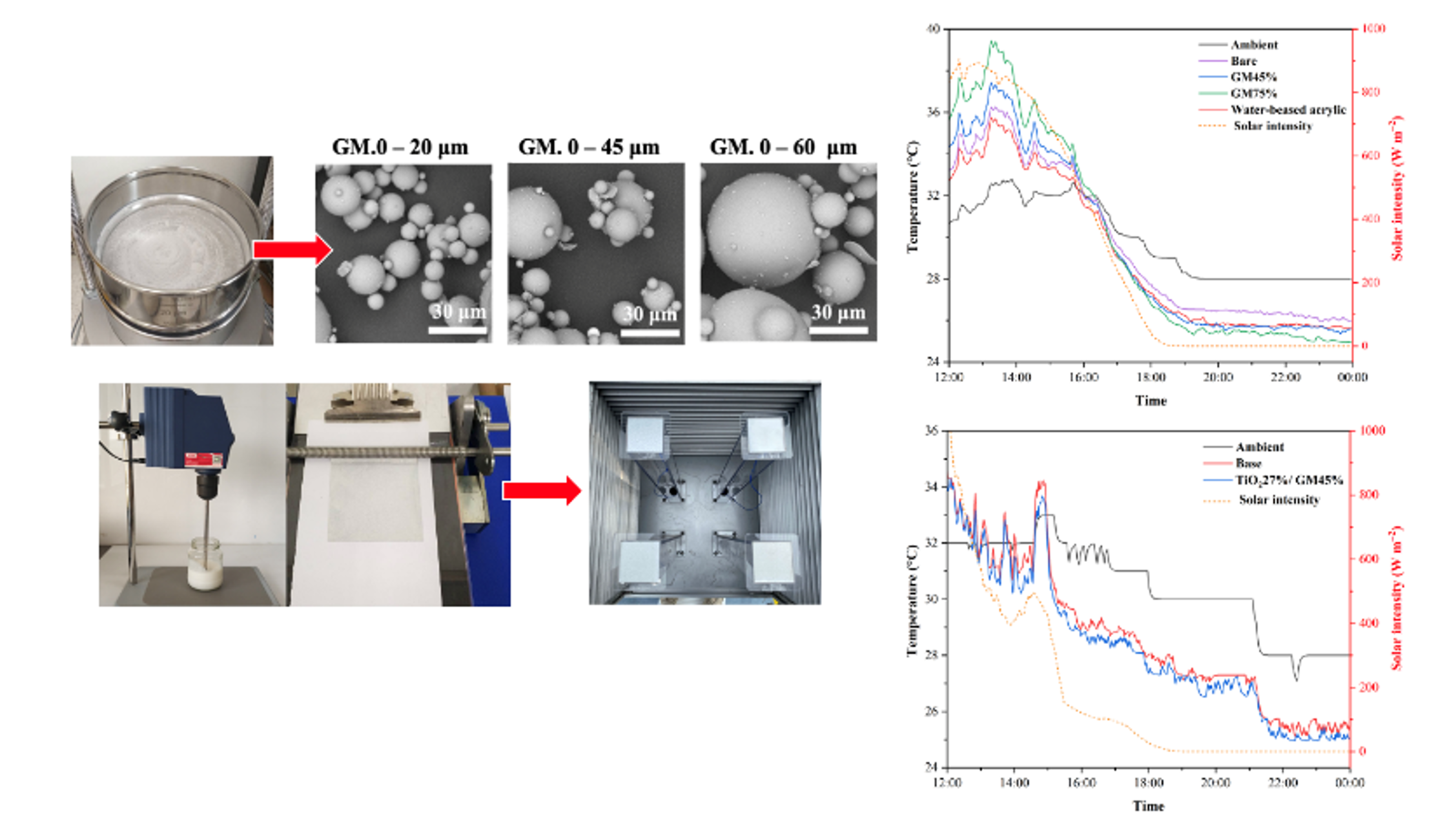An alternative nighttime radiative cooling paint using glass microspheres in water-based acrylic paint
DOI:
https://doi.org/10.55674/cs.v15i3.251830Keywords:
Glass Microsphere, Radiative Cooling, Water-Base Acrylic PaintAbstract
An alternative method for producing radiative cooling paint using sustainable and cost-effective green materials, which can significantly reduce indoor temperatures. Prior research on radiative cooling systems revealed that multilayer metal oxide systems require expensive raw materials and high-end facilities, limiting large-scale production. Therefore, this study aimed to identify optimal conditions for producing radiative cooling paint using commercial spherical glass microspheres and titanium dioxide nanoparticles. The study investigated the effect of glass microsphere size, quantity, and coating thickness on emissivity and light reflectance. Results showed that glass microsphere size did not significantly affect emissivity. However, increasing coating thickness and glass microsphere quantity initially increased emissivity but stabilized at saturation points. The addition of glass microspheres decreased light reflectance, increasing temperatures during the daytime. The radiative cooling efficiency of the paint was tested, and the results showed that the glass microsphere content significantly affected the reduction in daytime temperatures. A mixture content of 45 and 75 wt% reduced the temperature by 2.96 and 3.09 °C, respectively, lower than the ambient temperature during the nighttime. The double layer of titanium dioxide/glass microspheres paint was more effective at cooling than the single layer of 45% glass microspheres, despite similar emissivity values.
HIGHLIGHTS
- Commercial spherical glass microspheres and titanium dioxide nanoparticles are used as raw materials.
- Glass microsphere quantity and coating thickness are found to affect emissivity and light reflectance.
- A mixture of 45 and 75wt% glass microsphere content is shown to significantly reduce nighttime temperatures.
- Double layer paint is more effective at cooling than single layer paint despite similar emissivity values.
GRAPHICAL ABSTRACT

References
L. Pérez-Lombard, J. Ortiz, C. Pout, A review on buildings energy consumption information, Energy Build. 40(3) (2008) 394 – 398.
R. Levinson, H. Akbari, J.C. Reilly, Cooler tile-roofed buildings with near-infrared-reflective non-white coatings, Build Environ. 42(7) (2007) 2591 – 2605.
J. Hu, X.B. Yu, Adaptive building roof by coupling thermochromic material and phase change material: Energy performance under different climate conditions, Constr Build Mater. 262 (2020) 120481.
K.T. Zingre, M.P. Wan, S. Tong, H. Li, V.W-C Chang, S.K. Wong, Modeling of cool roof heat transfer in tropical climate, Renew. Energy. 75 (2015) 210 – 223.
S. Chavanavesskul, Management of the urban spatial setting to determine the effect of urban heat island on the Bangkok Metropolis, Thailand, Sustainable Development and Planning IV. 120 (2009) 53 – 63.
A.P. Raman, M.A. Anoma, L. Zhu,
E. Rephaeli, S. Fan, Passive radiative cooling below ambient air temperature under direct sunlight, Nature. 515 (2014) 540 – 544.
S. Atiganyanun, J.B. Plumley, S.J. Han, K. Hsu, J. Cytrynbaum, T.L. Peng, Effective radiative cooling by paint-format microsphere-based photonic random media, ACS Photonics. 5(4) (2018) 1181 – 1187.
R.F. Ribeiro, L.A. Martínez-Martínez, M. Du, J. Campos-Gonzalez-Angulo, J. Yuen-Zhou, Polariton chemistry: controlling molecular dynamics with optical cavities, Chem Sci. 9(30) (2018) 6325 – 6339.
X. Yu, J. Chan, C. Chen, Review of radiative cooling materials: Performance evaluation and design approaches, Nano Energy. 88 (2021) 106259.

Downloads
Published
How to Cite
Issue
Section
Categories
License
Copyright (c) 2023 Creative Science

This work is licensed under a Creative Commons Attribution-NonCommercial-NoDerivatives 4.0 International License.








